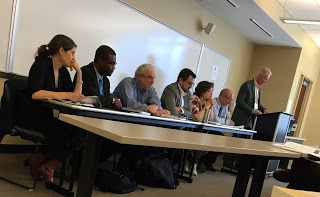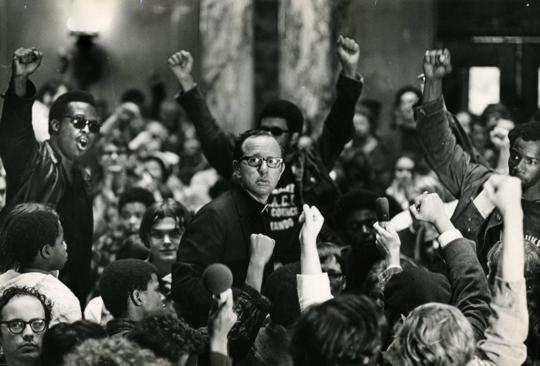

| Online: | |
| Visits: | |
| Stories: |

| Story Views | |
| Now: | |
| Last Hour: | |
| Last 24 Hours: | |
| Total: | |
“Parish Boundaries” at 20: A Roundtable
Monday, November 14, 2016 9:29
% of readers think this story is Fact. Add your two cents.
Today's post is the first in a series dedicated to John McGreevy's classic text Parish Boundaries: The Catholic Encounter with Race in the Twentieth-Century Urban North. Inspired by a roundtable held at the Urban History Association's biannual meeting in Chicago, the series brings together scholars of both religion and the American city to assess the legacy of McGreevy's work on the occasion of its twentieth anniversary. The first post comes from Amanda Seligman, a professor of history at the University of Wisconsin-Milwaukee. The author most recently of Chicago’s Block Clubs: How Neighbors Shape the City (Chicago, 2016), Seligman is an urban historian by training and her post reflects upon the impact McGreevy's book had upon the study of the American city. Posts from the roundtable's other participants will follow every day this week, and the series will conclude with McGreevy's response.
 |
| Incoming UHA President Timothy Gilfoyle, who convened the roundtable, kicking off the proceedings. |
As an urban historian, it is an honor to have the opportunity to reflect on John McGreevy’s Parish Boundaries for a religious history blog. Along with Arnold Hirsch’s Making the Second Ghetto and Thomas Sugrue’s Origins of the Urban Crisis, Parish Boundaries was one of the three most influential books that I read in graduate school. That trio of books set the basic parameters for my research in the early part of my career, encapsulating what we knew about the making of racial segregation in the urban north and pointing the way to unanswered questions.
The posts in this series reflect the richness of Parish Boundaries. Because each of us identifies distinctive themes, it is worth spelling out what I understood to be McGreevy’s central argument: white American Catholics had a bifurcated response to the growing numbers of African Americans in the urban north in the 20th century. This was not a split between the clergy and laity. Rather divisions occurred within each of these groups, and the divisions combined differently in different places. McGreevy traces increasing racial liberalism among American Catholics in the 20th century, which allows him to provide an optimistic ending. Without saying so explicitly, McGreevy suggests that white Catholic hostility to African Americans was rooted in conceptualizations of the importance of property and property ownership, and that racial liberalism was rooted in careful reading of Catholic doctrine.
Notably, McGreevy’s project had an unusual scope. Instead of offering a case study of a single city that left extrapolation to the reader, Parish Boundaries took on the urban north as a whole. He traveled to ten cities to make use of local archives and synthesized his findings. [1] Because it requires making sense of so many local stories before contextualizing them, this difficult approach is taken too rarely in urban history.
As I re-read Parish Boundaries this time, I reflected on what the title meant and how it evolved from the staid title of McGreevy’s 1993 Stanford dissertation, “American Catholics and the African-American Migration, 1919-1970.” In my first two readings of the book—once shortly after it came out and once with leading a graduate seminar at the University of Wisconsin-Milwaukee—I thought of the boundaries in physical terms. I thought of the parish boundaries as coterminous with strictly-enforced neighborhood racial boundaries. It seemed that McGreevy was underscoring that white Catholics did not have room in their neighborhoods for African Americans—even for black Catholics. In this third reading, however, I thought of the boundaries differently. Early in the book, McGreevy describes ethnic parishes as the standard practice of the American church in the first part of the twentieth century. Their boundaries overlapped physically, but not psychologically. Taken as a metaphor for the argument as a whole, the boundaries came across more like psychological limits or cultural constraints that circumscribe the conflict in the book.
 |
| Father James Groppi. |
Finally, Parish Boundaries integrates stories about two white priests who loom large in my own research: Francis X. Lawlor and James Groppi. In locally-oriented, twenty-first century scholarship, it is easy to villainize the one and heroicize the other.
Father Lawlor, who operated on the South Side of Chicago, was a teacher and school administrator who became the spearhead for block club organizing to keep out blacks. He was indubitably a racist. In an era when whites were becoming more cautious about the language used to articulate their racism, often encoding or softening it, Lawlor was not hesitant. He forthrightly proclaimed racial differences between blacks and whites. He suggested that blacks might overcome those differences in time, but until that happened, whites must be protected from having blacks live among them. Chicago’s Cardinal Cody exiled Lawlor to Tulsa, Oklahoma, but Lawlor defiantly came back to continue his organizing and was ultimately elected alderman. I very much appreciate McGreevy’s careful observations about Lawlor’s rhetoric, noting that, “He incessantly invoked what he perceived as the parallel example of the civil rights movement.” (232) This description of Lawlor’s tactics is exactly right, although his rhetorical borrowings were not limited to the civil rights movement. Lawlor listened very carefully to what his opponents did and said and cleverly adapted those approaches to his own ends.
James Groppi was a white priest in Milwaukee who spearheaded two hundred consecutive nights of marching for open housing from the fall of 1967 through the spring of 1968. As a white leader of black activists in Catholic context, Groppi looms very large in Milwaukee civil rights historiography. Most local writing about Groppi is fundamentally hagiography, casting him as heroic without careful reflecting on his significance beyond Milwaukee. Parish Boundaries, however, interprets the national significance of the Milwaukee movement as the “site of the most sustained Catholic encounter with urban issues.” (197) Most locally-based histories of Groppi’s work omit this important context.
What happened to James Groppi after his two hundred nights in the national spotlight? He was part of church’s hemorrhaging of young priests in the 1970s, which McGreevy tells us was annually 4.6% of priests between 29 and 34. (246) After leaving the priesthood, Groppi married Margaret Rozga and became a father, worked as a Milwaukee city bus driver, and died untimely young of a brain tumor. Rozga is a retired University of Wisconsin-Waukesha faculty member in English who has done much to keep James Groppi’s memory front and center in Milwaukee’s collective memory.
Unfortunately, McGreevy’s perspective on both of these priests is underappreciated and hard to access. Although search mechanisms have come a long way since Parish Boundaries’ publication in 1996, casual perusal of the book’s overt subject headers disguises some of the gems within. Unless local researchers concur on their own with Parish Boundaries’ ultimate point that the white urban response to African Americans in northern cities was a Catholic response, they may well never find the book it in the first place. This loss is unfortunate especially for junior scholars working at the thesis level, so it is very good to have the opportunity to remind ourselves what an important book Parish Boundaries remains.
[1]Baltimore, Boston, Buffalo, Chicago, Cleveland, Detroit, Milwaukee, New York, Philadelphia, Pittsburgh
A Group Blog on American Religious History and Culture
Source: http://usreligion.blogspot.com/2016/11/parish-boundaries-at-20-roundtable.html


